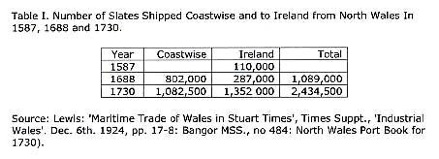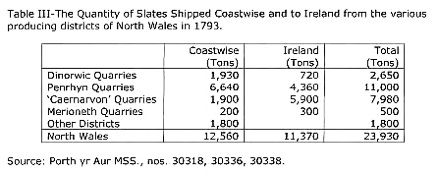Historical aspects of the Welsh slate industry
D Dylan Pritchard MA FSS
Historical aspects of the Welsh slate industry
D Dylan Pritchard MA FSS
The population of England and Wales increased from some three millions in 1500 to about five and a half millions in 1700; this growth in population, together with the contemporaneous development of manufactures and mining, had marked repercussions upon building and ancillary trades. The constructional industries became exceptionally active and there were important new developments in technique. The serious timber shortage in the country accelerated the substitution of brick and stone for timber in construction; houses were henceforth built more sturdily and consequently the expansion in the demand for heavier varieties of roofing materials was greater even than for roofing materials generally.
In meeting this demand roofing-tile manufacturers enjoyed overwhelming differential advantages over slate producers. Deposits of clay were distributed over a wide area in happy juxtaposition with seams of coal, which were at that time being vigorously opened out. The costs of tile production were probably greatly reduced by using coal instead of charcoal in the firing process, and the plants were in close proximity to the great markets as it was in the coal districts and along the Thames Valley that the greatest growth in population took place. It was the distribution of deposits of clay and coal at the focal points where population concentrated which enabled the brick, tile, and coal industries to expand rapidly during the sixteenth and seventeenth centuries.
Nature had neither distributed deposits of slate on such a lavish scale nor over a wide area: production was confined to five districts - Argyllshire, the Lake District, Cornwall and Devon, South-west Wales and North-west Wales - all situated along the west coast. The land sale of slate was very small on account of the high cost of inland carriage which precluded any large sale at distances of more than fifteen to twenty miles from the quarries; furthermore, the hinterland of the slate producing areas was very sparsely populated. Transport by water was substantially cheaper than by land and sea-carriage made it possible for slate to enjoy a comparatively wide market. "The high-commended slate of Cornwall" was shipped coastwise to ports along the south coast, where it competed with the equally celebrated slate of Angers which was imported in small quantities; Cornish slate was also exported to the Netherlands and to Brittany. The produce of the Argyllshire quarries was disposed of along the western coast of Scotland, but as early as 1737 there is a record of a cargo of Easdale slate being shipped as far as the London market. (Trans. Gaelic Society of Inverness, vol. xxiii. p 291.)
Archaeological research has established the fact that in the third century the Romans used slate for flooring and roofing purposes at their forts at Segontium and Caer Lligwy in North-west Wales. Slate was also used contemporaneously in the so-called Romano-British settlements, but exclusively for the manufacture of domestic implements such as loom-weights and skin-scrapers. From the time the Romans left our shores until the Edwardian Conquest there is very little positive evidence that slate was being used. Edward I certainly used slate to roof parts of his castles at Caernarvon, Conway and Carmarthen. From that time onwards there is voluminous evidence that it was customary to dig "oute stone slates to kyver houses" in those areas where there were outcrops of slate rock. A Frenchman who passed through North Wales in 1399 left it on record that in Conway there was "much slate on the houses." In the fifteenth century we have evidence that slate was being quarried in the Nantlle, Ogwen and Conway valleys of Caernarvonshire, in the Berwyn range, at Aberllefenny in South Merionethshire, and in various parts of Pembrokeshire.
After 1583 slate became the principal export from Wales to Ireland; in the Year 1587 some 110,000 slates were shipped there from the ports of Beaumaris and Caernarvon. Although, as the late Dr. Lewis points out in his excellent book "Welsh Port Books, 1550-1603," there are no extant port books to prove the existence of a coasting trade in slates in North Wales in the sixteenth century, it is practically certain that such a trade existed in view of the long-standing and close economic link between the North Wales littoral and Chester, the creeks of the Dee, and Liverpool. There is some rather meagre but interesting evidence pointing to the fact that such a trade existed. Sometime between 1480-1502 Guto'r Glyn, a noted Welsh bard, composed, on behalf of his patron Sir Griffith ap Einion, a cowydd addressed to Dr. Richard Kyffin, Dean of Bangor, asking for a cargo of slate to he sent from Aberogwen to Rhuddlan. (National Library of Wales MSS., no. 3050 D.) In 1570 Sion Tudur, another celebrated poet, sent a cowydd to Rowland Thomas, Dean of Bangor, begging for a cargo of slate to be sent from Aberogwen to Rhyl in order to enable him to replace the thatched roof of his cottage which had rotted and was letting in the rain. (Jones: Ceinion Llenyddiaeth Gymraeg vol. ii.) These two poems provide strong evidence that slates were shipped coastwise in the sixteenth century from the Caerhir Quarry which was apparently situated on episcopal land in the Bethesda district, probably on the site of the now world-famed Penrhyn.
There are no statistics of the total output of slate during this period but Table I gives the number of slates shipped at various dates from North Wales which, since the end of the eighteenth century has been by far the most important producing area.

[Table 1 as published was incorrectly type set. The values have
been re-calculated]
The above table does not present a true picture of the growth of the slate shipping trade in North Wales as it does not take into account the changes which took place in the size and weight of slates produced in that area. The slates shipped in 1587 and 1688 were almost exclusively "Doubles," measuring not under 12 x 6 inches and weighing at that time some 16 cwts. per mille. In 1730 "Ladies," measuring not under 15 x 8 inches, as well as Doubles, were produced and these then weighed about 25 cwts. per mille. By making rough adjustments for the change in the sizes of slates during this period, it is possible to convert the numbers of slates shipped into tonnages and so obtain a comparable series of statistics. This has been done in Table II below.

The above table makes it clear that the shipment of slate from North Wales was very minute and although it was nearly ten times greater by 1793, the actual scale of production remained small, as is indicated in Table III

In 1782, the numerous small quarries on the Penrhyn estate had been taken over into his own hands by the land-owner who had developed them energetically; six years later the Dinorwic Slate Company was formed to take over and exploit the small quarries on the south side of the Elidyr. In 1703 these two concerns together produced more than half the total output of North Wales and it is significant that as high a proportion as two-thirds of their production was shipped coastwise to the new markets created by the Industrial Revolution, whereas the smaller quarries in the Llanberis district and in the contiguous Nantlle district sent only a quarter of their output coastwise and the remainder to the old-established markets in Ireland. The minor slate districts of Denbighshire and Montgomeryshire sent their produce along canals to the English market; only small sizes of slates were, produced in those districts but in the Caernarvonshire area practically all the quarries turned out sizes up to and exceeding 22 X 11 inches. These larger sizes found a ready market as their use made possible a considerable economy in timber, of which there was a serious shortage as a result of the war with France.
Table IV below gives a rough estimate of the total output of roofing slate in Great Britain in the year 1793.

During the second half of the eighteenth century the industry had begun to expand rapidly, but on the eve of the outbreak of the Napoleonic Wars the estimated total output of slate amounted only to 45,000 tons. The land sale of slate remained negligible and the water sale, despite its accelerated rate of growth, was still inconsiderable.
In the last decade of the century the growing demand for roofing material in those districts where population was growing most rapidly was in the main still met by the tile industry; in many districts, more especially the southern and eastern counties, thatch predominated, whereas in the English Pennines, particularly in Derbyshire and the West Riding of Yorkshire, stone slates produced locally, from fissile sandstones or limestone were in general use. But with the coming of the new century slate came into its own and before that century was out the output of slate had reached the 600,000 tons mark. In a very real sense the slate industry was the product of the Industrial Revolution.
Early days of the slate industry
Quarry Managers' Journal July 1942
First series
Early days
Second series
Third Series
Other slate information
National archive slate records
Links

Penrhyn Quarry